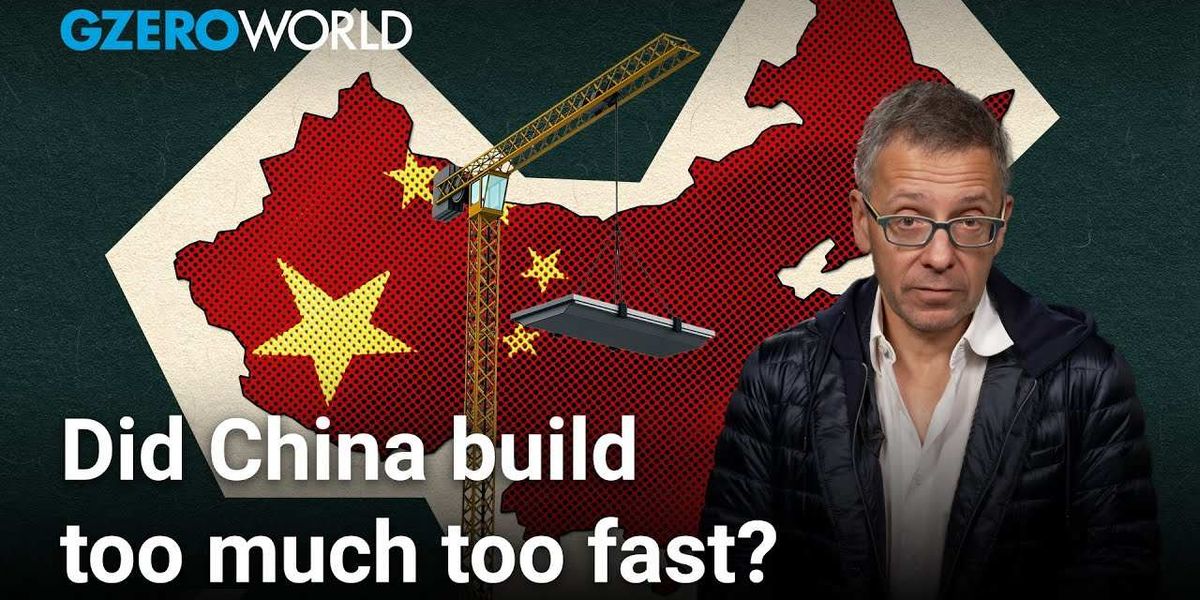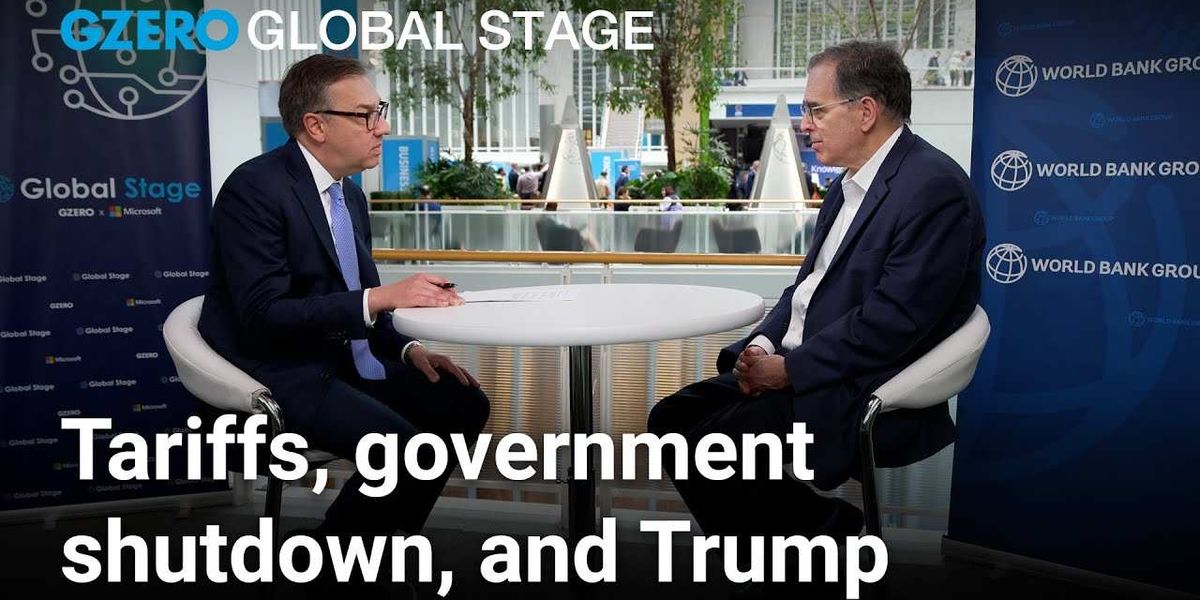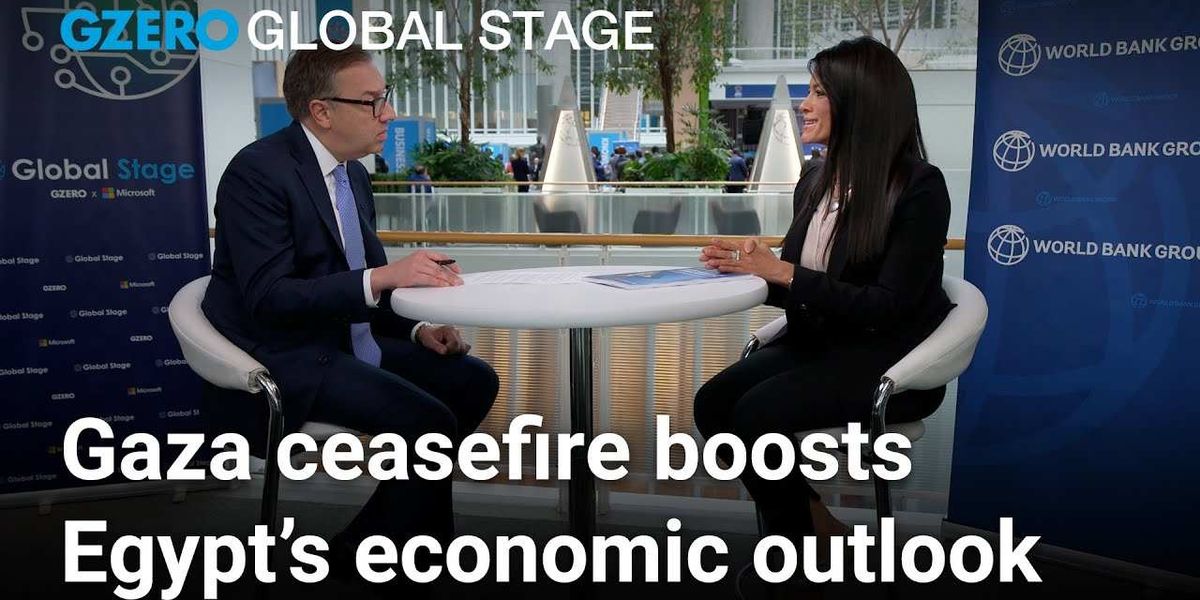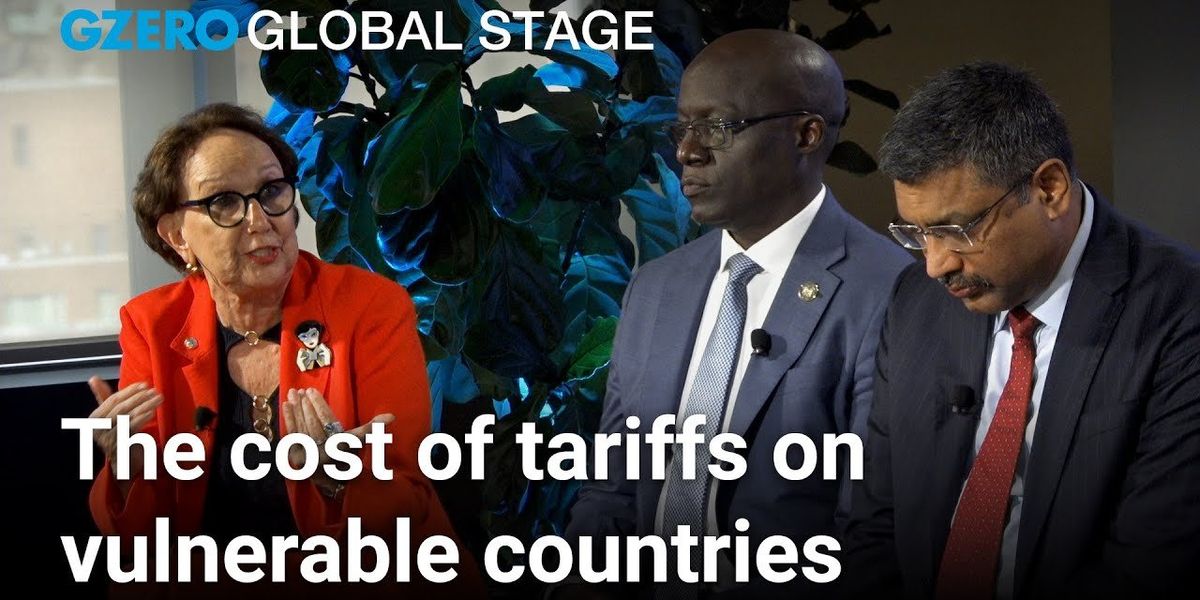Trending Now
We have updated our Privacy Policy and Terms of Use for Eurasia Group and its affiliates, including GZERO Media, to clarify the types of data we collect, how we collect it, how we use data and with whom we share data. By using our website you consent to our Terms and Conditions and Privacy Policy, including the transfer of your personal data to the United States from your country of residence, and our use of cookies described in our Cookie Policy.
{{ subpage.title }}
It's not a matter of "if" but "when"
Andrew Ross Sorkin says the next financial crisis is coming
In 1929, unchecked speculation and economic hype helped fuel the worst financial crash in modern history. Nearly a century later, New York Times journalist and CNBC anchor Andrew Ross Sorkin sees troubling parallels. On the GZERO World podcast, he joins Ian Bremmer to talk about his new book, "1929: Inside the Greatest Crash in Wall Street History—and How It Shattered a Nation," and whether today’s economy is headed for another cliff.
Sorkin warns that behind today’s AI boom and market exuberance lies an undercurrent of fragility—historic debt levels, shaky private credit markets, and investors chasing returns with little oversight. While the technology behind AI is real, much of the money flooding in feels familiar to those who’ve studied speculative bubbles before. “We're not going to have another 1929,” Sorkin says, “but I think it's very possible. Actually, I would argue it's almost impossible for us not to have another 1999.” He sees eerie parallels between the past and the present: massive speculative investments, surging inequality, and a public increasingly disconnected from financial realities.
But one thing stands out today: silence. Sorkin warns that many CEOs and financial leaders, despite recognizing the risks, are unwilling to speak out publicly. “If we ever get to a moment where we need to make very difficult decisions,” he says, “are there going to be leaders willing to stand up and explain what needs to happen?”
Subscribe to the GZERO World Podcast on Apple Podcasts, Spotify, Stitcher, or your preferred podcast platform, to receive new episodes as soon as they're published
What the US can learn from China's infrastructure boom
But after the boom, often comes the bust. China’s experience can be both a roadmap and a warning. The results of its building spree have been astounding: more high-speed rail than the rest of the world combined, soaring GDP growth, hundreds of millions lifted into the middle class. But the People’s Republic is now dealing with a stagnating economy. Local governments that financed all that construction are drowning in debt. China bet on physical infrastructure. The US is gambling on digital. If AI doesn’t deliver on its promise, both could end up in the same place: buried under the weight of their own ambition.
GZERO World with Ian Bremmer, the award-winning weekly global affairs series, airs nationwide on US public television stations (check local listings).
New digital episodes of GZERO World are released every Monday on YouTube. Don't miss an episode: subscribe to GZERO's YouTube channel and turn on notifications (🔔). GZERO World with Ian Bremmer airs on US public television weekly - check local listings.
Government shutdown and trade tensions test US economy
As the US economy continues to defy expectations, Eurasia Group Managing Director of Global Macro Robert Kahn says the key question is whether a slowdown has been avoided or merely delayed. “The headline here is the impressive resilience of the US, maybe also the global economy over the last six months,” Kahn tells GZERO Media’s Tony Maciulis on the sidelines of the 2025 World Bank–IMF Annual Meetings.
He points to an AI-driven boom and tariff dynamics as major short-term supports, while warning that these trends may not be sustainable. Kahn also highlights deep uncertainty in the US–China trade relationship, describing a “fragile” moment of misunderstanding and escalation. Looking ahead, he flags the uneven nature of US growth and a prolonged government shutdown as key risks that could shift the economic outlook heading into the end of the year.
This conversation is presented by GZERO in partnership with Microsoft. The Global Stage series convenes global leaders for critical discussions on the geopolitical and technological trends shaping our world.
Egypt's path to economic stability with Rania Al-Mashat
As a landmark Gaza ceasefire reshapes Middle East stability, what does it mean for Egypt’s growth outlook?
Egypt’s Minister of Planning, Economic Development, and International Cooperation, Rania Al-Mashat tells GZERO’s Tony Maciulis the deal is “a monumental moment” and durable. “There’s no development without stability and peace,” she says, citing urgent Gaza reconstruction.
Despite recent changes, Egypt achieved a 5% economic growth, fueled by strategic reforms and a robust tourism sector. Highlighting progress, Al-Mashat shared Egypt's success in attracting over $17 billion in private sector investment, focusing on key industries like ICT and manufacturing. She notes, “Our economy has been rebounding, recovering very steadily.”
This conversation is presented by GZERO in partnership with Microsoft.. The Global Stage series convenes global leaders for critical discussions on the geopolitical and technological trends shaping our world.
How the circular economy empowers small businesses
Listen: Imagine an economy where products are designed to be reused, repaired, and regenerated instead of ending up as waste. That’s the circular economy, a model that redefines recycling and transforms how small businesses operate.
In this episode of "Local to Global: The power of small business," host JJ Ramberg sits down with Ellen Jackowski, Chief Sustainability Officer at Mastercard, and Rachel McShane, Chief Financial Officer at Depop, to discuss the scale of the circular economy, why circular practices boost both sustainability and profitability, and where the industry is headed next.
From Depop’s sustainable fashion marketplace that empowers small sellers and extends the life of clothing to Mastercard’s digital solutions that enhance the consumer experience and measure impact, the discussion highlights ways entrepreneurs can launch reuse, resale, and take-back programs. The conversation also addresses the pitfalls of greenwashing and the importance of credible, consistent standards.
“Local to global: The power of small business” is a new podcast series from GZERO Media's Blue Circle Studios and Mastercard, where we'll look behind the curtain to explore the world of small businesses and why they’re positioned to play an even bigger role in the future of the global economy.
September 28, 2025, Tehran, Iran: Iranian lawmakers participate in an open session of parliament. Iran has recalled its envoys to Britain, France, and Germany for consultations after the three countries.
Do additional sanctions on Iran make a difference now?
The European Union confirmed on Monday that it has reinstated sanctions on Iran over its nuclear program, following the United Nations’ decision over the weekend to reimpose its own penalties.
The move piles fresh punishment onto an economy already battered by a collapsing currency, soaring inflation and deficits, and chronic shortages of water and energy. Iran is also still reeling from the 12-day war in June, which included US airstrikes on its three main nuclear sites and a wave of Israeli attacks on sensitive government targets.
What’s in these sanctions? They reinstate bans on arms imports and on the transfer of dual-use technologies that could support a nuclear program. The measures also freeze the assets of individuals linked to Iran’s missile and nuclear efforts, impose travel bans on sanctioned officials, and authorize inspections of Iranian cargo, including oil shipments. All of this comes atop extensive financial sanctions that the US has imposed since 2018.
Why are they called “snapback” sanctions? They were previously lifted, as part of a 2015 nuclear deal between Iran, the US, and Europe, on the condition that Iran continue to allow international inspection of its nuclear programs to ensure that they are for peaceful use. The US exited that deal in 2018, reimposing sanctions, but European partners continued some of its terms. After the war with Israel, Iran suspended access to inspectors, opening the way for these sanctions to automatically “snap back” into place.
Economic impact. The effects are already rippling out over Iran’s currency markets. The rial is now trading at more than a million per US dollar and fell another 4% on the black market on Saturday. That slide is eroding the purchasing power of the middle class and squeezing quality of life. Eurasia Group Iran expert Greg Brew described the sanctions’ practical impact as “largely symbolic and psychological,” warning that they will deepen public disillusionment by reducing prospects for diplomacy and long-promised sanctions relief.
“The impact of the last few years of sanctions has been to increase inequality in Iran,” says Brew. “More of the wealth and more of the power is moving upward, while the middle class has been squeezed and shrunk.”
Could that generate a fresh wave of protests? Possibly, as Iran has seen a number of economic-driven protests in recent years. But the political impact would likely be limited, in Brew’s view. "Iran has no organized political opposition,” he says, “There's really no locus around which the opposition can mobilize and the internal repressive apparatus is still as large and as powerful as it has always been, if not more."
Nuclear diplomacy stalled. The purpose of the sanctions is to pressure Iran to return to meeting its obligations under the Nuclear Non-Proliferation Treaty (NPT), which requires Tehran to forswear nuclear weapons development and accept international inspections.
"What we're looking at in the short term is Iran remaining within the NPT in name only," says Brew. Since the 12-day War, Iran has been skirting the treaty’s spirit by denying inspectors access to key facilities and refusing to clarify the status of its enriched uranium. The regime has made the decision to weather more sanctions rather than allow international inspections, underscoring the question: what, exactly, is going on at Iran’s nuclear facilities now?Global trade is experiencing a tectonic shift, says UNCTAD's Rebeca Grynspan
The Trump administration’s tariffs have added uncertainty and complexity to global trade, particularly burdening emerging and developing economies.
UNCTAD Secretary-General Rebeca Grynspan calls this a “tectonic shift in the trade regime,” noting that negotiations have replaced a potential tariff war.
She warns that vulnerable countries are being hit hardest often facing higher tariffs than major US trading partners despite posing little threat. Grynspan urges the US government to reconsider these trade measures to avoid devastating impacts.
Watch more Global Stage coverage from the 80th Session of the United Nations General Assembly here: gzeromedia.com/globalstage
Trump's silhouette as a wrecking ball banging into the Federal Reserve.
Trump’s attacks on the Fed will backfire
President Trump has made no secret of his longstanding desire for lower interest rates to juice the economy and reduce the cost of servicing the $30 trillion federal debt. But his attacks on the Federal Reserve will prove self-defeating, driving up borrowing costs for American consumers, businesses, and the federal government.
For months, the president has threatened and insulted Fed chair Jerome Powell for refusing to cut rates, even toying with the idea of firing him over supposed (and nakedly pretextual) cost overruns on the renovation of the Fed’s headquarters. Yet despite the bluster, he has stopped short of the one move advisers warned him could turn financial markets against him: actually sacking him. Why risk it when Powell’s term as chair expires in May, at which point Trump (who appointed him in 2018) will get to select a replacement more willing to do his bidding?
The president even got an unexpected chance to fill a Federal Reserve Board seat last month when Fed governor Adriana Kugler resigned under suspiciously hasty circumstances before the end of her term, allowing Trump to nominate his economic advisor Stephen Miran to succeed her. You’d think that’d be good enough to keep him placated for a while. Not so.
On Aug. 25, Trump posted a letter to Truth Social announcing he was firing Federal Reserve Board governor Lisa Cook over mortgage fraud allegations from before she joined the Fed. This unprecedented escalation – the first attempt to fire a Fed governor in presidential history – followed a politically motivated investigation started by the Federal Housing Finance Agency’s Bill Pulte, a Trump loyalist and donor who has weaponized his government position to make similar accusations against other MAGA political enemies (California Sen. Adam Schiff and New York Attorney General Letitia James).
Cook, a Biden appointee whose term is set to run until 2038, has refused to resign and is contesting the dismissal. The Supreme Court recently ruled that presidents have wide latitude to fire the heads of independent agencies, but it made a point to carve out an exception for the Fed, whose governors can only be removed “for cause.” What that means exactly, no one knows … because no president has ever tried to fire a Fed governor. Until now.
Although the Department of Justice has launched a criminal investigation into the allegations, Cook hasn’t yet been charged with a crime. It’s unclear whether an allegation of malfeasance that predates Cook’s employment at the Fed and is unrelated to her job meets the judicial bar for “cause” set by the Federal Reserve Act. The matter will be decided by the courts, which granted Cook a preliminary injunction last night, allowing her to stay in the job while the case gets litigated.
Of course, this isn't really about mortgage fraud – it's about seizing control of the Fed. Trump’s not coy about the endgame. On Aug. 26, the president bragged that “We’ll have a majority very shortly, so that’ll be great.” Trump already has two appointees on the Federal Reserve Board, Chris Waller (a favorite to succeed Powell as chair) and Michelle Bowman, and he will likely get a third soon once Miran gets confirmed. If the president ultimately succeeds in pushing out Cook, he’ll have appointed four of the board’s seven members, possibly before Powell even steps down.
That wouldn’t be enough to directly control the 12-person Federal Open Market Committee that sets rates. But a four-person Federal Reserve Board majority would have veto power over the appointment of the regional Fed presidents who sit on the FOMC – and those presidents just so happen to be up for reapproval for five-year terms at the end of February in what's normally a rubber-stamp vote, raising the stakes of both the outcome and the timing of the Cook ruling. Not that the administration needs to actually fire every independent-minded dissenter to chill dissent: sometimes, the demonstration effect of seeing some of your colleagues’ lives ruined is enough to sway behavior.
Yet even if Trump succeeds in stacking the FOMC with loyalists (a big if), the president will still struggle to get what he wants most out of this whole enterprise: substantially lower borrowing costs.
The crux of the issue is that the Fed only has direct control over short-term interest rates, but most borrowers care about long-term rates, which are determined by market expectations of future economic growth, inflation, and fiscal policy. The more the president leans on the Fed, the greater the compensation demanded to hold long-term bonds, as investors lose confidence in the Fed’s ability to keep inflation under control no matter the political costs to the president.
Accordingly, the benefits to Trump of pushing for lower interest rates than merited by economic conditions would likely be offset by large and sustained increases in long-term yields. In the worst-case scenario, Trump forces the Fed to set rates inappropriately low, causing inflation to rise and damaging the Fed’s credibility. By the time the president starts feeling the political pain of runaway prices and orders the Fed to reverse course, the genie is already out of the bottle: inflation expectations are unanchored, long-term rates have spiked, and the Fed is forced to print ever more money to pay for the mounting costs of servicing a growing debt pile. This may sound like the story of an emerging market, but it’s becoming suddenly plausible for the United States.
The last time a US president messed with the Fed’s independence was when Richard Nixon strong-armed Fed chair Arthur Burns into keeping rates low ahead of the 1972 presidential election, causing inflation to spike. It took a decade and punishingly high interest rates to get runaway inflation under control and rebuild the Fed’s credibility, long since understood to be a key pillar of America’s world-beating economy and the dollar’s reserve currency status. Most Wall Street leaders understand the risks of going down the same path again, even if they are too timid to speak out publicly against it (with few exceptions).
So why the muted market reaction? Maybe investors doubt Trump can pull this off. After all, we've been down this road with President Trump before – he's been threatening the Fed since 2017 to little effect. Or maybe investors assume he'll back down in the face of any significant bond market fallout – the so-called TACO trade. But what if that market calm emboldens him to push harder? By the time investors wake up, the damage may be done. As Hemingway wrote about bankruptcy, crises happen gradually, then suddenly.
The real irony? Trump is ramping up his Fed attacks just as he's about to start getting the rate cuts he wants – though not for reasons he'll like. Two weak jobs reports show his tariffs, immigration crackdown, and policy volatility are beginning to weigh on the labor market. The Fed will almost certainly cut rates next week, even if not as aggressively as Trump demands given signs of rising inflation.
If Trump truly wants to lower borrowing costs for Americans, he should stop attacking the Fed and start cutting the deficit. Otherwise, the president will head into the midterms with a slowing economy, soaring prices, and higher long-term rates. Turns out not even the world’s most powerful man can bully bond markets into submission.



